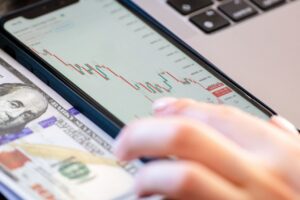What is Forex Risk Management and Why is it Important for Traders?
Forex risk management is the process of limiting and controlling the potential risks associated with trading in the foreign exchange market. By managing risk effectively, traders can protect their capital from sudden losses or unexpected events, while also taking advantage of opportunities for greater gains. Risk management is essential to successful forex trading, as it allows the trader to enter and exit positions with confidence when market conditions change.
Learning how to manage your risk is a key component of becoming a successful forex trader. Here are some strategies that experienced traders use to limit their exposure:
- Diversification – Spread out your investments across different markets and currency pairs so you reduce your overall risk exposure. Having too much money invested in one area can be dangerous, as any unexpected event can cause a large loss.
- Setting Stop Losses – Setting stop losses on your trades is one of the most important aspects of risk management. A stop loss helps to limit potential losses by closing out a trade when it reaches a predetermined level. This helps to ensure that traders don’t lose more money than they are willing or able to lose in a single trade.
- Employing Proper Money Management – Money management involves making sure you keep enough capital and reserve funds for trading while still being able to invest adequately in each position taken. By controlling the amount of money invested in each trade, traders are more likely to maintain a positive balance even if some trades fail due to market volatility.
- Trading with the Trend – One of the most effective ways to manage risk is by trading with the trend. By following the direction of an established trend, traders are less likely to suffer losses due to unforeseen events or sudden shifts in market conditions.
Types of Risks in Forex Trading and How to Avoid Them
Forex trading carries certain risks that are important to be aware of when planning your trading strategy. Here are some of the most common types of risks and how traders can avoid them:
- Market Risk – This type of risk is caused by shifts in the overall market conditions, such as fluctuations in exchange rates or economic news events. To reduce exposure to these risks, traders should pay attention to current events and use tools like stop losses and hedging strategies.
- Leverage Risk – Leverage allows traders to control larger positions with a smaller amount of capital, but it also increases their potential losses if the trade does not go in their favor. To reduce this risk, traders should only use leverage within their comfort level and closely monitor their trades for potential losses.
- Liquidity Risk – Liquidity risk occurs when traders are unable to enter or exit a trade due to a lack of buyers or sellers in the market. To reduce this risk, traders should stay up-to-date on current market conditions and be prepared to adjust their strategy accordingly.
Setting a Forex Trading Strategy for Reducing Risk
When developing a forex trading strategy, it is important to consider risk management first and foremost. As mentioned above, setting stop losses and properly managing your money are key components of reducing risk in the foreign exchange market. Other strategies include limiting your exposure to any one currency pair or asset class, diversifying across different markets, and using tools like moving averages or Bollinger bands for technical analysis. By following a comprehensive risk management plan and understanding the risks associated with forex trading, you can maximize your potential for profits while minimizing potential losses. With practice and patience, traders can learn how to manage their risk effectively so they can experience greater success in the markets.
Developing Money Management Strategies to Protect Your Capital
Money management is an important part of forex trading and should be considered before entering any trade. To reduce risk exposure, traders should set limits on how much capital they will allocate to each trade and establish a maximum proportion of their portfolio at risk. They should also consider factors like the maximum drawdown they are willing to accept and the amount of leverage used in each trade. By establishing strict money management rules, traders can protect their capital from sudden losses and ensure that they are only taking prudent risks when entering positions in the market. This type of discipline can help traders remain consistent with their trading strategy while still allowing them to take advantage of profit opportunities.
Applying Risk Mitigation Techniques to Reduce Losses
Risk mitigation is the process of reducing and controlling potential losses that can occur during forex trading. To reduce their risk exposure, traders should employ various strategies such as setting stop losses on their trades, avoiding overtrading, and learning to accept small losses when necessary. Additionally, traders should protect themselves from market volatility by using hedging techniques or diversifying across different asset classes. By following these risk mitigation techniques, traders can limit the potential of large unexpected losses while still maintaining a profitable strategy in the foreign exchange market.
Utilizing Automated Trading Platforms for Increased Security
Automated trading platforms allow traders to set up their trades in advance and can be used to reduce risk exposure. Automation eliminates the need for manual monitoring and allows traders to set predetermined parameters such as stopping losses or taking profit levels. Additionally, automated trading robots can analyze the market 24/7 so that traders no longer have to rely solely on their judgment when making decisions. With automation, traders can rest assured that their trades are being executed accurately and quickly, with minimal human intervention required.
By developing a comprehensive risk management plan and utilizing automated trading tools, traders can increase their potential for profits while reducing their risks in the volatile forex market. With practice and discipline, they can become successful currency investors who can identify opportunities and minimize losses.
Conclusion
Forex risk management is an essential part of successful trading, as it helps protect traders from unexpected losses while allowing them to take advantage of opportunities for greater gains. By understanding the different types of risks associated with forex trading and employing proper money management strategies, investors can make informed decisions that will help them achieve greater success in the markets. With these tips in mind, you can start to build a profitable trading strategy that will help you reach your goals and ensure long-term success.



